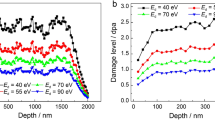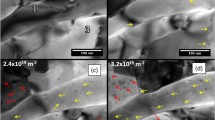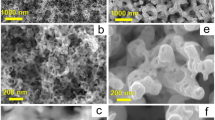Abstract
This work deals with the formation kinetic of tungsten (W) blisters under smooth plasma conditions, i.e. low hydrogen flux and energy in order to analyze the first stages of their formation. In addition, we focus on determining the W grain orientation where blisters grow preferentially. For this purpose, mirror-polished polycrystalline tungsten samples were exposed to hydrogen plasma under fixed hydrogen flux of 2.2 × 1020 m−2 s−1, with a fluence in the range of ~ 1024 m−2, ion energy of ~ 20, 120 and 220 eV, and sample surface temperature of ~ 500 K. The formation of blisters at the surface was investigated using SEM, AFM and EBSD to determine the size, the distribution and the orientation of grain where blisters are formed, respectively. The critical fluence for initiating blisters was established around 2.3 × 1024 m−2. The evolution of blister size distribution and density is discussed as function of fluence and ion energy. At lower ion energy, i.e. 20 eV, only nanoblisters (less than 150 nm) are observed whatever the fluence value (1.5 and 2.3 × 1024 m−2). At higher ion energy i.e. 120 and 220 eV, micrometric (~ few to tens of µm) blisters are observed and their density highly depends on fluence. We show that blisters can also be formed on (001) oriented grains contrarily to previous results from the literature where the (111) orientation seemed more favorable. Such information is of importance for tungsten based fusion tokamak operation and design.










Similar content being viewed by others
References
C.P. Medeiros, M.H. Alencar, A.T. de Almeida, Hydrogen pipelines: enhancing information visualization and statistical tests for global sensitivity analysis when evaluating multidimensional risks to support decision-making. Int. J. Hydrog. Energy 41, 22192–22205 (2016). https://doi.org/10.1016/j.ijhydene.2016.09.113
T. An, H. Peng, P. Bai, S. Zheng, X. Wen, L. Zhang, Influence of hydrogen pressure on fatigue properties of X80 pipeline steel. Int. J. Hydrog. Energy 42, 15669–15678 (2017). https://doi.org/10.1016/j.ijhydene.2017.05.047
Y. Yürüm, A. Taralp, T.N. Veziroglu, Storage of hydrogen in nanostructured carbon materials. Int. J. Hydrog. Energy 34, 3784–3798 (2009). https://doi.org/10.1016/j.ijhydene.2009.03.001
D.V. Schur, M.T. Gabdullin, V.A. Bogolepov, A. Veziroglu, S.Y. Zaginaichenko, A.F. Savenko et al., Selection of the hydrogen-sorbing material for hydrogen accumulators. Int. J. Hydrog. Energy 41, 1811–1818 (2016). https://doi.org/10.1016/j.ijhydene.2015.10.011
E. Fakioğlu, Y. Yürüm, Veziroğlu T. Nejat, A review of hydrogen storage systems based on boron and its compounds. Int. J. Hydrog. Energy 29, 1371–1376 (2004). https://doi.org/10.1016/j.ijhydene.2003.12.010
W. Han, Y. Yan, J. Gu, Y. Shi, J. Tang, Y. Li, Techno-economic analysis of a novel bioprocess combining solid state fermentation and dark fermentation for H2 production from food waste. Int. J. Hydrog. Energy 41, 22619–22625 (2016). https://doi.org/10.1016/j.ijhydene.2016.09.047
J. Habibian, A. Salar Elahi, M. Ghoranneviss, M.K. Salem, S. Saviz, Plasma equilibrium reconstruction for the nuclear fusion of magnetically confined hydrogen isotopes. Int. J. Hydrog. Energy 41, 15266–15271 (2016). https://doi.org/10.1016/j.ijhydene.2016.06.178
F. Ren, W. Yin, Q. Yu, X. Jia, Z. Zhao, B. Wang, Solution and diffusion of hydrogen isotopes in tungsten-rhenium alloy. J. Nucl. Mater. 491, 206–212 (2017). https://doi.org/10.1016/j.jnucmat.2017.04.057
A. Hu, A. Hassanein, Predicting hydrogen isotope inventory in plasma-facing components during normal and abnormal operations in fusion devices. J. Nucl. Mater. 465, 582–589 (2015). https://doi.org/10.1016/j.jnucmat.2015.06.048
I.M. Dmytrakh, R.L. Leshchak, A.M. Syrotyuk, R.A. Barna, Effect of hydrogen concentration on fatigue crack growth behaviour in pipeline steel. Int. J. Hydrog. Energy 42, 6401–6408 (2017). https://doi.org/10.1016/j.ijhydene.2016.11.193
B. Meng, C. Gu, L. Zhang, C. Zhou, X. Li, Y. Zhao, et al. Hydrogen effects on X80 pipeline steel in high-pressure natural gas/hydrogen mixtures, in Spec Issue 6th International Conference on Hydrogen Safety ICHS 2015 19–21 Oct 2015 Yokohama Jpn 2017;42:7404–12. https://doi.org/10.1016/j.ijhydene.2016.05.145
S. Ayadi, Y. Charles, M. Gaspérini, I. Caron Lemaire, T. Da Silva Botelho, Effect of loading mode on blistering in iron submitted to plastic prestrain before hydrogen cathodic charging. Int. J. Hydrog. Energy 42, 10555–10567 (2017). https://doi.org/10.1016/j.ijhydene.2017.02.048
X. Ren, W. Chu, J. Li, Y. Su, L. Qiao, The effects of inclusions and second phase particles on hydrogen-induced blistering in iron. Mater. Chem. Phys. 107, 231–235 (2008). https://doi.org/10.1016/j.matchemphys.2007.07.004
A.V. Nikitin, G.D. Tolstolutskaya, V.V. Ruzhytskyi, V.N. Voyevodin, I.E. Kopanets, S.A. Karpov et al., Blister formation on 13Cr2MoNbVB ferritic-martensitic steel exposed to hydrogen plasma. J. Nucl. Mater. 478, 26–31 (2016). https://doi.org/10.1016/j.jnucmat.2016.05.032
C. Quirós, J. Mougenot, G. Lombardi, M. Redolfi, O. Brinza, Y. Charles et al., Blister formation and hydrogen retention in aluminium and beryllium: A modeling and experimental approach. Nucl. Mater. Energy (2016). https://doi.org/10.1016/j.nme.2016.12.036
V. Philipps V, Tungsten as material for plasma-facing components in fusion devices, in Proceedings of 19th International Conference on Plasma-Surf aces Interactions Control Fusion 415:S2–S9 (2011). https://doi.org/10.1016/j.jnucmat.2011.01.110
S. Lang, Q. Yan, N. Sun, X. Zhang, C. Ge, Microstructures, mechanical properties and deuterium blistering behavior of chemically prepared W-TiC alloys. J. Fusion Energ. 36, 71–79 (2017). https://doi.org/10.1007/s10894-017-0124-3
S. Semsari, A. Zakeri, A. Sadighzadeh, S. Khademzadeh, M. Sedaghat, M. Torabi et al., Comparison of high-energy He + and D + irradiation impact on tungsten surface in the IR-IECF device. J. Fusion Energ. 32, 142–149 (2013). https://doi.org/10.1007/s10894-012-9540-6
M.V. Roshan, M.M. Darian, Experimental study of plasma materials’ interaction in plasma focus “Dena”. J. Fusion Energ. 22, 79–82 (2003). https://doi.org/10.1023/B:JOFE.0000021558.30726.01
W.M. Shu, A. Kawasuso, Y. Miwa, E. Wakai, G.-N. Luo, T. Yamanishi, Microstructure dependence of deuterium retention and blistering in the near-surface region of tungsten exposed to high flux deuterium plasmas of 38 eV at 315 K. Phys. Scr. 2007, 96 (2007)
M. Miyamoto, D. Nishijima, Y. Ueda, R.P. Doerner, H. Kurishita, M.J. Baldwin, S. Morito, K. Ono, J. Hanna, Observations of suppressed retention and blistering for tungsten exposed to deuterium–helium mixture plasmas. Nucl. Fusion 49, 065035 (2009)
Armin Manhard, Martin Balden, Udo von Toussaint, Blister formation on rough and technical tungsten surfaces exposed to deuterium plasma. Nucl. Fusion 57, 126012 (2017)
K. Ouaras, K. Hassouni, L.C. Delacqua, G. Lombardi, D. Vrel, X. Bonnin, Tungsten dust nanoparticles generation from blistering bursts under hydrogen environment in microwave ECR discharge. J. Nucl. Mater. 466, 65–68 (2015). https://doi.org/10.1016/j.jnucmat.2015.07.035
K. Ouaras, S. Dine, D. Vrel, X. Bonnin, M. Redolfi, G. Lombardi et al., Synthesis and hydrogen plasma interaction of model mixed materials for fusion. Int. J. Hydrog. Energy 39, 17422–17428 (2014). https://doi.org/10.1016/j.ijhydene.2014.08.021
K. Ouaras, L.C. Delacqua, G. Lombardi, J. Röpcke, M. Wartel, X. Bonnin et al., In-situ diagnostics of hydrocarbon dusty plasmas using quantum cascade laser absorption spectroscopy and mass spectrometry. J. Plasma Phys. 80, 833–841 (2014). https://doi.org/10.1017/S0022377814000361
M.H.J. ‘tHoen, D. Dellasega, A. Pezzoli, M. Passoni, A.W. Kleyn, P.A. Zeijlmans van Emmichoven et al., Deuterium retention and surface modifications of nanocrystalline tungsten films exposed to high-flux plasma. PLASMA-Surf. Interact. 21, 463–989 (2014). https://doi.org/10.1016/j.jnucmat.2014.11.025
M.H.J. ’tHoen, M. Balden, A. Manhard, M. Mayer, S. Elgeti, A.W. Kleyn, P.A. Zeijlmans van Emmichoven et al., Surface morphology and deuterium retention of tungsten after low- and high-flux deuterium plasma exposure. Nucl. Fusion 54, 083014 (2014)
H.Y. Xu, G. De Temmerman, G.-N. Luo, Y.Z. Jia, Y. Yuan, B.Q. Fu et al., Deuterium-induced nanostructure formation on tungsten exposed to high-flux plasma. PLASMA-Surf. Interact. 21(463), 308–311 (2015). https://doi.org/10.1016/j.jnucmat.2014.11.039
F. Liu, H. Ren, S. Peng, K. Zhu, Effect of crystal orientation on low flux helium and hydrogen ion irradiation in polycrystalline tungsten. Nucl. Instrum. Methods Phys. Res. Sect. B Beam Interact. Mater. At. 333, 120–123 (2014). https://doi.org/10.1016/j.nimb.2014.04.004
C.M. Parish, H. Hijazi, H.M. Meyer, F.W. Meyer, Effect of tungsten crystallographic orientation on He-ion-induced surface morphology changes. Acta Mater. 62, 173–181 (2014). https://doi.org/10.1016/j.actamat.2013.09.045
O. El-Atwani, S. Gonderman, M. Efe, G. De Temmerman, T. Morgan, K. Bystrov, J.P. Allain, Ultrafine tungsten as a plasma-facing component in fusion devices: effect of high flux, high fluence low energy helium irradiation. Nucl. Fusion 54(8), 083013 (2014)
Acknowledgements
This work was supported in part by ANR project ANR-09-BLAN-0070-01 (CRWTH), and by FR-FCM under contract 1IPH.FR.13.31. Special thanks are due to Ovidiu Brinzia for his assistance in obtaining the EBSD patterns micrographs.
Author information
Authors and Affiliations
Corresponding author
Rights and permissions
About this article
Cite this article
Ouaras, K., Redolfi, M., Vrel, D. et al. Tungsten Blister Formation Kinetic as a Function of Fluence, Ion Energy and Grain Orientation Dependence Under Hydrogen Plasma Environment. J Fusion Energ 37, 144–153 (2018). https://doi.org/10.1007/s10894-018-0161-6
Published:
Issue Date:
DOI: https://doi.org/10.1007/s10894-018-0161-6




